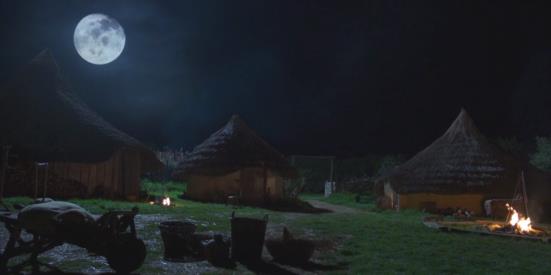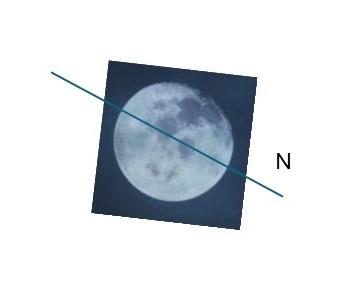
NavList:
A Community Devoted to the Preservation and Practice of Celestial Navigation and Other Methods of Traditional Wayfinding
From: Frank Reed
Date: 2024 Feb 3, 08:20 -0800
Murray Buckman, you wrote:
" I think the poles are in about line with the line I have inserted in the attached image. I am struggling to see how this view of the moon could be seen from a terrestrial location and suspect it is an image from NASA taken from one of the Apollo missions - probably a well known image from Apollo 11"
Yes, the Moon makes no sense. The image was acquired in deep space, probably during one of the Apollo missions. But since it also looked this way in a scene in one of the Harry Potter movies, there is another possibility: a secret British space station in deep space originally built to defeat an alien invasion but now converted to a film studio (that inverts the setup of an old "groovy" British space opera called "UFO" which hid its headquarters for alien defense inside an active film studio down here on Earth). If they are filming at the right location in space, maybe near the L4 Lagrangian point, then the Moon could look something like this.
Here's the image again (screen capture from a film about "Boudicca"), for anyone who may have missed it:
Some of you may be wondering how the heck we can tell this photo of the Moon was taken in deep space?! And it's because the Moon always shows just one side to us here on the Earth. The familiar features of the Full Moon that we have seen since the dawn of our species are all we ever see of the Moon. We see half the Moon, plus a few percent. Because of the eccentricity of the Moon's orbit (which implies that its orbital revolution cannot be perfectly synchronized with its rotation on its axis), we see a bit more than half the Moon. There are a few other factors involved and collectively these are known as the lunar "librations". But still from here on Earth, the Moon's features always look very nearly the same. We see the "Near Side" half of the Moon. In particular there's a dark grey circular basin, foreshortened to an oval, on the Moon's "upper right shoulder" (upper in the northern hemisphere) that's always seen as a sort of "eye" close to the trailing edge of the Moon's limb. That eye is known as Mare Crisium. And if you look at this photo, seen in the Boudicca film and also in that Harry Potter movie (and many other films and images), you realize that Mare Crisium is nearly at the center of this Moon image (a bit towards lower right, but close to center). It's not foreshortened so it's nice and round, too. And that means that roughly one-third (or more) of the Moon in the image is part of the Far Side --which is never seen from Earth ...never!
How does this happen? Well, clearly someone in production for the video in question hit the clip art gallery for a Moon image. And one of the most popular (probably because, since it's a NASA image, there are no licensing restrictions) dates back to Apollo 11. There are a few nearly identical images from later Apollo Moon flights if you decide you want an exact match. After the mission at the Moon was completed, and the LM (lunar module) disposed, the big service module engine would fire at low altitude on the back side of the Moon and send the spacecraft out of lunar orbit. Within a few hours, it would be high above the trailing limb of the Moon looking down on Mare Crisium just as in this photo. Of course when astronauts return to the Moon in the next few years, they will see thiw view again, and they could also stop for a dry martini, "zero-g, no acceleration" with you-know-who at the secret British film studio which necessarily (based on the Moon photos) is located up there, too.
There's more... Mare Crisium is larger than it should be. It occupies a bigger fraction of the Moon's disk than it should, and you can measure this. This photo was actually taken at relatively low altitude above the Moon. At the time the Moon would have loomed enormous behind the Apollo spacecraft as it was departing. It's actually possible to work out the approximate height above the Moon based on the 'perspective' of the Moon in the image. And from that the original angular diameter of the Moon at the time the photo was taken follows...
Matus Tejiscak, you commented that the Moon is much too big, and it is (for a proper Moon seen from here on the Earth). But it's amusing to note that the original diameter (at the time and location where the photo was taken) would actually have been far larger in angular size! So it's an impossible size for the Moon in two distinct ways.
Getting back to the tilt of the Moon, Murray B, you included this image with your estimate of the Moon's axis. Yes, I agree! So ignoring the other issues, if you saw the Moon like this, with its north pole "down and to the right" on the apparent lunar disk, the direction indicated by the axis would be towards the pole of the ecliptic (give or take 5° since the Moon's orbit is tilted by that much relative to the ecliptic). The north pole of the ecliptic, in this case, would be 90° away "down and to the right" from the Moon. It's very roughly halfway between Vega and Polaris, in the middle of the constellation Draco. That location would probably be below or close to the horizon in the context of this image. The north celestial pole (Polaris) would be 23.45° away, which means our little Celtic village here must be in the tropics (Boudicca! What are you up to?!). Incidentally, 180° away, the south ecliptic pole is quite near the LMC (Large Magellanic Cloud) in the constellation Dorado. Draco and Dorado... hmmm. I never noticed how easy that is to remember! If you picture the Solar System on a flat plane, like an orrery, directly "above" the plane is Draco and directly below is Dorado with the LMC.
Frank Reed
Clockwork Mapping / ReedNavigation.com
Conanicut Island USA






